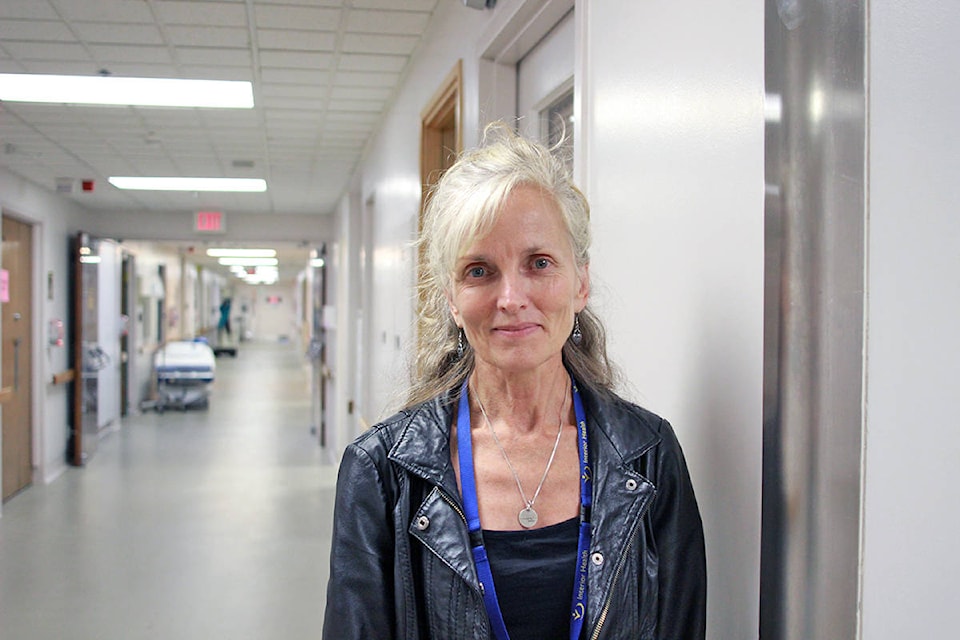Rural community hospitals are experiencing staffing shortages to the point where many are wondering if patient care is being compromised.
“100 Mile House is no different from many of other hospitals in the province where staffing can be challenging,” said Allison Filewich, acute care nurse manager.
According to Filewich, 100 Mile District General Hospital has been actively recruiting but it can be difficult for a hospital in a small town to compete with hospitals in more urbanized areas. A hospital in an urbanized area is more likely to be chosen than one located remotely. Despite the competitive nature, Filewich said she has been able to have some luck.
Adriane Gear, who is the executive counsellor for the BC Nurses’ Union (BCNU) said baseline staffing can be extremely “lean”.
“Even if there are enough nurses that are expected on a shift, meeting patient care needs can be challenging. If you do not have enough nurses to provide the care, you can imagine some of that care is being missed,” said Gear.
Gear attended the Internal Council of Nurses Congress last month and said reports suggest there will be a global shortage of 7.6 million nurses by the year 2030.
“I can confirm that the BCNU is concerned about the professional nursing shortage in B.C.,” said Gear. “Hospitals, home and communities are all impacted.”
On a typical day, the 100 Mile District Hospital will have two registered nurses (RN) and two licensed practical nurses (LPN) in acute care. In the emergency, there will be two nurses on the floor and one who will float.
Read more: 100 Mile District Hospital recognized for a unique project focused on patients mobility
“Having said that, we are staffed well, on most days,” said Filewich. “Our staff are very committed to providing quality care - we do our very best.”
Filewich explained the team always has a contingency plan, which sometimes requires shuffling employees from days to nights and vice versa.
“Nurses will prioritize and provide essential care but the reality is patients don’t always receive the care they require,” said Gear. “It’s a supply and demand issue.”
Gear said there are many facets as to why units are short. The unit could be short because of the number of nurses on the baseline and being overcapacity.
“In these (rural) communities, tourism or increased traffic volume on the highways can lead to an increase in emergency room visits,” said Gear. “Hospitals don’t have that capacity, so they might have more patients than beds, which would require more staffing for a baseline.”
In 100 Mile, the hospital has been funded enough for a total of 16 beds on the acute ward of the hospital where two registered nurses and one licenced practical nurse normally provide care 24/7. However, their current census ranges from 18 to 20 patients on most days, which has demonstrated the need for the addition of their baseline nursing staff of one licenced practical nurse.
“I think a lot of the staffing strategies that ultimately the employer relies on is overtime,” said Gear. “The system is run on copious amounts of overtime.”
Read more: 100 Mile District Hospital celebrates completion of ED/Triage renovation
Filewich explained that rural communities such as 100 Mile, might not have all of the allied health care resources that might be seen in a more urban area. Filewich said the nurses often take on many other roles to fill in the gaps where allied health is not available.
“We would like to see the government step up and create some recruitment strategies,” said Gear. “Recruitment and retention is a challenge. What we are seeing, is that some communities can be successful at recruiting nurses but it’s that retention piece. If a nurse is hired to a hospital where the work environment is not optimal due to workload or it feeling as safe as it should be, people don’t stay.”
Gear said if a hospital doesn’t have a strategy to retain nurses and don’t provide a “safe” workload for nurses to provide the care they’ve been trained to, hospitals may start to struggle with keeping their staff.
Filewich spoke highly of the team in 100 Mile House, saying it was one of the highest functioning teams she has ever seen.
“Our patient care coordinator has spent much time educating and bringing everyone’s scope of practice up to where it needs to be,” said Filewich.
Gear said because of the demand for nurses, hospitals need to provide quality work environments for the employees - so their staff is retained and patients can receive the care that is required.
“People are very willing to roll up their sleeves and come in to work an extra shift but that can’t be the strategy,” said Gear. “People are getting tired.”
newsroom@100milefreepress.net
Like us on Facebook and follow us on Twitter.
